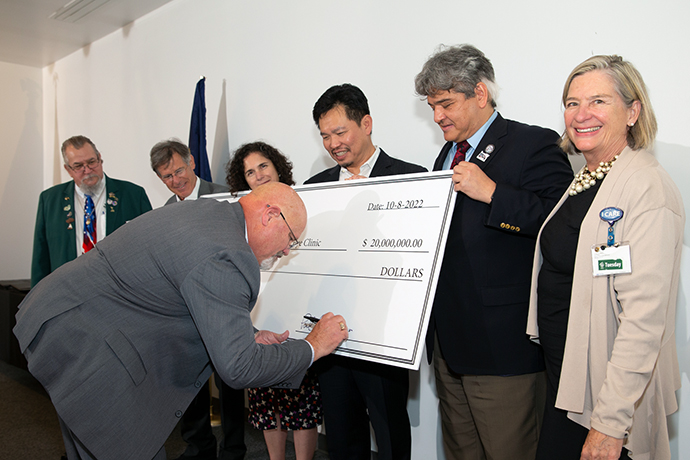
On October 8 the Casey community and the Oregon State Elks Association were finally able to celebrate the grand opening of the Elks Children’s Eye Clinic (ECEC) building on Marquam Hill. Over a hundred people gathered on a beautiful, dry fall day for the long-anticipated event. The culmination of many years of planning, fundraising and building, the new facility is the first free-standing children’s eye clinic in the nation. The ECEC officially opened in 2020 but, due to the Covid-19 pandemic, the clinic could only open its doors to staff and patients until now.
The Grand Opening was a celebration of the historic facility and an occasion to recognize the incredible role the Oregon State Elks Association have played in Casey’s success over decades.
“I have always been impressed by how much the Elks care about each and every child. They love to hear patient stories, and how our clinic was able to make their lives better,” said Leah Greenhill Reznick, M.D., director of the Elks Children’s Eye Clinic. “What drives them is a love of helping children. And I think that's a really beautiful thing to celebrate.”
The event featured festive food and drink, clinic tours, and a formal program that included remarks from David Wilson, M.D., Andy Lauer, M.D., and Lanny Schultze, EYES President. Lanny presented a check to complete the Oregon Elks donation of $20 million. Take an online tour of the Elks Children's Eye Clinic.
Casey’s relationship with the Oregon State Elks Association is exceptional in its longevity and productivity. It started in 1949, when the Elks helped Kenneth Swan, M.D., the first ophthalmology department chair of the then-University of Oregon Medical School, establish a children’s eye clinic. That clinic would go on to outgrow its initial space and become the first Elks Children’s Eye Clinic, which was located on the fifth floor of the Casey Eye Institute facility.
Back in the 1950s, Swan suspected premature babies were going blind because of oxygen levels in incubators. He asked for the Elks’ help in purchasing an advanced piece of equipment to examine the issue further. The oximeter helped Swan understand that less oxygen was needed in incubators to ensure the vessels in preemies’ retinas didn’t grow out of control, a condition that became known as retinopathy of prematurity, or ROP.
With this discovery, doctors in the Department of Ophthalmology developed treatments for ROP that would allow premature children to retain their sight. Today, Casey continues to lead the field in finding new ways to prevent, detect and treat ROP.
As the ECEC flourished, Casey renewed its commitment to ending preventable blindness in Oregon and beyond. Not only were pediatric eye care services and its outreach program running at full throttle, but Casey’s groundbreaking gene therapy program and other ophthalmology services were rapidly growing in size and scope. It became apparent that more space was needed to better serve patients, promote collaborations between researchers and clinicians and house the latest technologies and tools.
Once again, the Oregon Elks played a central role. Backed by a $20 million pledge from the fraternal organization, OHSU and Casey leadership started planning for a new state-of-the art facility that they would name the Elks Children’s Eye Clinic, in recognition of the Oregon Elks’ significant philanthropic investment.
Today, the new 60,000 square foot building is home to a spacious pediatric eye clinic, ROP telemedicine, outreach programs, retina services, vision rehabilitation, the Paul H. Casey Ophthalmic Genetics floor and a clinical trials center.
Joannah Vaughan, M.B.A., founder and director of the Elks Preschool Vision Screening Program at Casey, has developed close ties to the organization over nearly 20 years. She pointed to several examples of the Elks providing seed money to crucial initiatives beyond the ECEC, including $1 million to start an informatics center, which eventually led to a groundbreaking discovery in using artificial intelligence to diagnose ROP, and money to start a preschool vision screening program in 2003, which was one of the first in the nation.
“The Elks members are the helpers in our community. These are the people who raise their hands to volunteer. Many of them as firefighters will carry you out of a burning building – it’s great to have them in our corner,” said Vaughan.